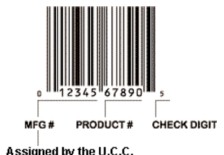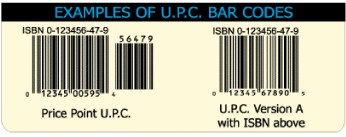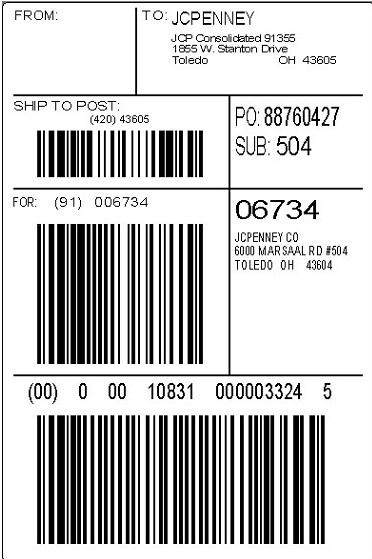Don’t spend big dollars trying to reinvent the wheel
Bar Code Examples
There are a number of different types of bar code languages
(symbologies) to satisfy varying applications and print requirements. The
listing below provides a brief description of some of the most common bar code
languages:
1. UPC-A & UPC-E
2. EAN
3. Code 3 of 9
4. Interleaved 2 of 5 (I 2/5) & ITF-14
5. Code 128
6. UCC/EAN-128
7. Codabar
8. Postnet
9. Pharmacode
10. PDF-417
- UPC-A

The UPC-A is most widely used and most recognized
symbol in the United States. Its primary usage has been for product
identification in the retail industry.
This symbol has a fixed length of twelve numeric characters. The data encoded
within a UPC-A conforms to a standardized format The twelfth digit of a UPC-A
symbol is a calculated check character computed from the eleven prior numbers.
UPC-E ![]()
2. EAN 
All other countries aside from the United States
utilize the EAN bar code for identification on retail goods. The symbol is
identical to the UPC-A with one exception, the EAN bar code represents
thirteen numeric characters instead of twelve.
3. Code 3 of 9 ![]()
Code 3 of 9 (also referred to as Code 39) is a very common bar code language which can represent alphanumeric characters of varying length. The start/stop characters for Code 39 symbols is always an asterisk (*).
4. Interleaved 2 of 5 (I 2/5)
![]()
Interleaved 2/5 is a high density code of variable
length. Only an even number of numeric data can be encoded within this symbol.
This “double density” symbol encodes odd positioned data in the bars, and
even positioned data in the spaces.
5. Code 128 
scanner read performance.
6. UCC/EAN-128

This language is a variation of the Code 128
symbology designed primarily for product/shipment identification applications.
The UCC/EAN-128 specification uses the same code set as Code 128, however a
special character (function 1) is used as part of the start code in the
symbol. In addition, UCC/EAN-128 symbols utilize standardized application
identifiers (AI’s).
7. Codabar 
Codabar is a self-checking language which encodes 16
data characters:0-9,6 special characters (-$:/.+).
8. Postnet ![]()
the individual bar code height alternates rather than the bar width.
9. Pharmacode ![]()
10. PDF-417 ![]()
PDF-417
is a high density code, two dimensional bar code consisting essentially of
stacked lower bar code sets. This symbology is able to encode all the ASCII
table characters (255).
UPC Example(Top)


UCC-128 labels
Retailers often require that bar-coded UCC-128 Shipping Container Label labels are affixed to incoming shipments. Prepared in association with a valid ASN transmission (advanced ship notice, or 856), UCC-128s connect the physical units of the shipment to the electronic information.
When a shipment is received, your trading partner scans the label and electronically matches it to the information in the ASN file. Labels follow a specific format and must contain accurate information. In addition, they must be legible, scan able, and associated with an ASN. Labels that do not meet these specifications may be assessed a chargeback, or expense offset fee.

